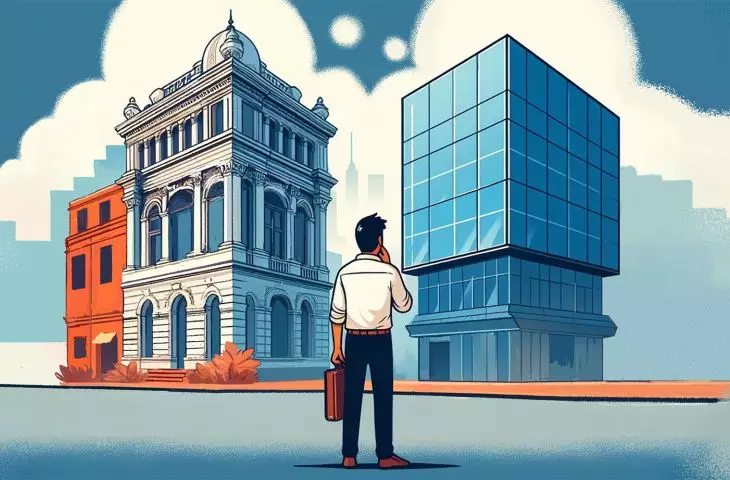Contemporary architecture, full of bold shapes and innovative solutions, goes beyond the boundaries of tradition, relegating classicism to the sidelines. Is this the result of evolution or a rebellion against established norms? Let's take a journey through the maze of contemporary buildings to discover why architects are increasingly abandoning classic elements in favor of modernity.
In the land of modern architecture, where modernity clashes with tradition, the city is transformed into a dynamic maze of historical details and concrete and glass facades. Looking at the skyline of modern neighborhoods, it is hard to find the classical elements that once dominated architecture. Why does modern architecture seem to be moving away from its roots?
modernity versus tradition
"The Teutonic Castle, so much like a shopping mall built between 2010and 2014," "So detached from any historical reflection? How can you promote such an example of elementary lack of culture. Barbaric, primitive box [...]" - these are just some of the comments under our post about the new development of the Teutonic castle in Radzyń Chełmiński. It's a student project, but for me, the response from the community in the comments, some of which probably came from another profile[1], indicated what a sizable portion of people unrelated to architecture were thinking.
modernity vs. tradition: a discussion of architecture majors
"Modern buildings are disgusting. They have no soul, are not interestingly finished and all look the same..." - we can read under my post taking a bit of a closer look at the Architecture Uprising trend, whose creators preach against what they call the "continuous disgust of cities." In doing so, they call for the return of design based on classic forms. All the complaints about modern architecture being bland fall into this trend. "I definitely prefer to look at historical architecture, because it is 'some kind of'. The buildings usually have a certain character, style, there is an idea there, not just 'building up the plot.' Modern buildings in most cases are crude, reduced to a minimum of angular, blocky masses, the design of which does not provide for any style. It's just about maximizing the return on investment for each m² built."
View this post on Instagram
We can also find a rash of such statements under the H11 Boutique Office project in Gliwice. The redevelopment and expansion of a former railroad building from the early 20th century, which was converted into an office building. Here, the architects opted for a bold addition to the massing of the two-story building with a sloping roof, which someone summed up as "look how much additional usable space was squeezed out!".
Let's move to Wieliczka. A new-old bus station has been standing here since 2021. It seems to refer to history, it is stylized as a historical monument, while at the same time looking to the future, a view from drones and maybe even a helicopter was also thought of - as the city's coat of arms was laid out on the roof. Initially there was to be a typically contemporary cube, with glazing, a flat roof, and simple metallic columns. However, the project in this form was not approved. The location is in a conservation zone, the provincial conservator of monuments issued recommendations to erect the building as a stylized historical one, including architectural details and the aforementioned tiled roof in sharp colors,[2] as well as increasing its usable area and budget.
Stobnica. It was here that a castle rose from nothing, suddenly and imperceptibly, without any king, knighthood or tsar. 15 floors above ground, several tens of meters of tower, as befits a castle, in a significant place, on the edge of the Notec Forest, in the Natura 2000 area. Access to the interior of the building is limited, but there is an opportunity to visit the educational path around the castle. In 2023, a 2.2 km long paid Forest Educational Path was opened. For a walk here you should expect to pay from 30 (a discounted and normal ticket during the week) to almost 50 zlotys (a normal ticket at the weekend). As we can read on the investment's website, "this unusual building, as well as the area around it, is the result of the work of a group of people fascinated by castle architecture, who created a residential building with such unusual architecture in modern times. An entire body of water surrounding the castle with a natural shoreline and numerous islands has also been created." Ultimately, it is expected to house 46 units, which can accommodate nearly a hundred people. It is projected that the value of the entire investment could eventually reach as much as 400 million zlotys.
Perhaps the Saski Palace would also land on the podium in the discussion of construction and reconstruction. "The Tomb of the Unknown Soldier in the remaining arcade is a very strong symbol and has grown into the landscape, including symbolically, of Warsaw. For me, this is one of the most serious arguments against the reconstruction," he said. - we can read in the comments. However, the more we delve into the subsequent profiles, we may encounter completely different voices.
Trends and controversies: architecture as a field of discussion
Antique architecture with its orders and proportions was the foundation of construction for centuries. Today, in new city neighborhoods, we rarely see Doric columns or reliefs on building facades. Modern architecture takes us to spaces filled with minimalist forms, glazing, and concrete. Does this mean that classicism is obsolete? It doesn't.
Zbigniew Rokita in his book "Odrzania. Journey through the Recovered Territories" mentions the German Jain, meaning Polish "both yes and no." In my opinion, it fits perfectly here. Is it not allowed to build in classicizing forms? Jain.
In architecture, each building is a separate story. It is impossible to define unequivocally how one should build. However, it is possible to start a discussion about why some decisions fall on glass cubes, while others fall on historicizing buildings. A good start to this conversation is a definition.
let's define it
Let's start with restoration. It's restoration, rebuilding, bringing a building back to its original condition. It includes a set of activities aimed at restoring a damaged or altered building to its former form. It is worth noting that the work is carried out on the basis of preserved archival materials in the form of plans, photographs, etc., using original details and preserving the surviving parts of the building. The term restoration is sometimes confused with the term conservation. This one is carried out all the time, as these are permanent and systematic activities aimed at keeping a historic building in good condition. Also important in this range of terms is modernization, that is, the upgrading of an existing, including historic object or set of objects (including parks). This is a permanent improvement, leading to increased value for the user. Modernization often includes changes to pre-existing functions.
However, what is reconstruction? As Article 3(6) of the Construction Law indicates, it is a type of ... construction that constitutes the performance of a building object, in a specific place. It is understood that reconstruction consists in the restoration of a damaged building, in the same place and with the preservation of the original size, shape and functional layout[3]. The fact that such an action has been undertaken raises serious controversy among art historians and architects. Reconstruction can only restore a lost object in its overall form and massing, the general impression of the object, but it will never be able to restore its original authenticity. The arguments are simple - construction and finishing work, however aesthetically perfect, cannot reflect the traces of the craftsmanship of a bygone period. We no longer have such tools, craftsmanship and... time to build with stone-carved details.
honesty in architecture
The concept of "sincerityin architecture" has also been with us since modernism. It refers to the quality of design, which is expressed in the transparent, truthful representation of a building's function, materials and construction. Architectural sincerity involves expressing the true features of a building, without artificial additions or camouflage. In practice, it can manifest itself through the prominence of the building's structure (elements such as columns, beams), the honest use of materials that clearly present their properties, not pretending to be something else. In this way, architecture becomes not only an aesthetic form, but also conveys information about its nature and principles of operation, which promotes an authentic experience and understanding of the building by its users.
critical regionalism
Perhaps on the borderline of these two extremes, offering a chance for compromise in the struggle over whether to build historically or modernly, is critical regionalism. This is an approach that combines local traditions with global trends in building design. Unlike traditional approaches that often focus on uncritical reproduction of local motifs and styles, critical regionalism sets itself the task of both integrating with the local context and critically analyzing and reinterpreting existing building forms, materials and techniques. This means that traditional architectural patterns can be used, but at the same time adapted to meet the contemporary needs and challenges of today. An example of this is the historic staircase, so often found in palaces and pseudo-dormitories. For any person with mobility limitations, such as driving a stroller with a child, such a space is inaccessible. Critical regionalism provides an opportunity to de-ventilate regime historical assumptions. It can draw on modern technologies and materials, combining them with local elements to create unique, accessible and sustainable buildings. It encourages a deeper understanding and appreciation of the local context, while promoting innovative approaches and the conscious use of cultural heritage in the design process.
public trust
There is no single golden rule that answers the question of whether to rebuild, build historically, or create modern buildings. On the other hand, there is an opportunity to discuss the subject a bit. Therefore, if even you, reading this text, have not learned_anything new, please pass this text on to the world. The architectural bubble likes to pat itself on the back, saying that "we are building wonderfully" and "people are not understanding anything". However, it just so happens that anyone who has that wonderful "arch." in front of their name also has a profession of public trust. For me, it's also a mission - education, and in that, discussion.
Magdalena Milert
[1] Specifically from the profile of the Secret Association of outspoken opponents of the Baroqueization of Gothic buildings
[2] https://dziennikpolski24.pl/barwny-dworzec-autobusowy-w-wieliczce-to-unikat-w-skali-polski-zdjecia/ar/c15-15648586
[3] Judgment of the National Board of Appeals of August 10, 2011, KIO 1607/11














